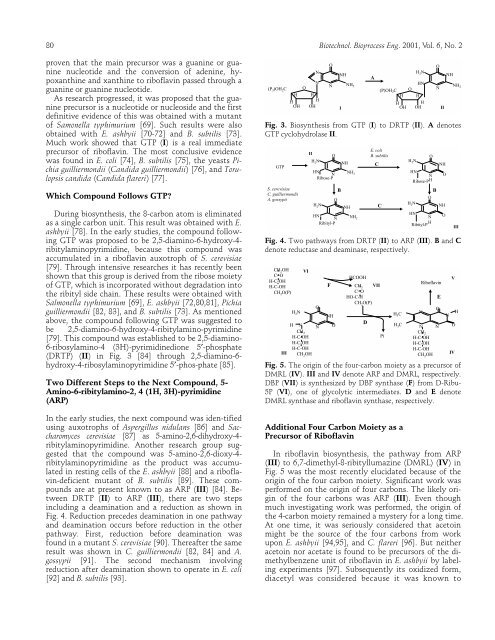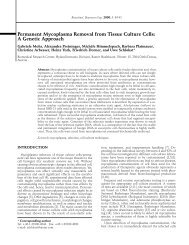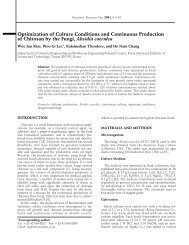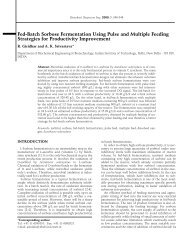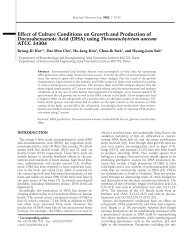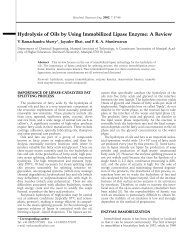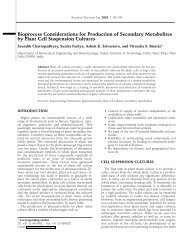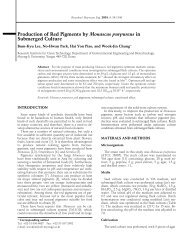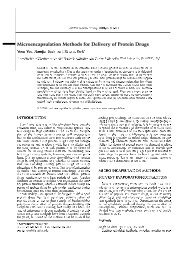Microbial Production of Riboflavin Using Riboflavin Overproducers ...
Microbial Production of Riboflavin Using Riboflavin Overproducers ...
Microbial Production of Riboflavin Using Riboflavin Overproducers ...
You also want an ePaper? Increase the reach of your titles
YUMPU automatically turns print PDFs into web optimized ePapers that Google loves.
80 Biotechnol. Bioprocess Eng. 2001, Vol. 6, No. 2<br />
proven that the main precursor was a guanine or guanine<br />
nucleotide and the conversion <strong>of</strong> adenine, hypoxanthine<br />
and xanthine to rib<strong>of</strong>lavin passed through a<br />
guanine or guanine nucleotide.<br />
As research progressed, it was proposed that the guanine<br />
precursor is a nucleotide or nucleoside and the first<br />
definitive evidence <strong>of</strong> this was obtained with a mutant<br />
<strong>of</strong> Samonella typhimurium [69]. Such results were also<br />
obtained with E. ashbyii [70-72] and B. subtilis [73].<br />
Much work showed that GTP (I) is a real immediate<br />
precursor <strong>of</strong> rib<strong>of</strong>lavin. The most conclusive evidence<br />
was found in E. coli [74], B. subtilis [75], the yeasts Pichia<br />
guilliermondii (Candida guilliermondii) [76], and Torulopsis<br />
candida (Candida flareri) [77].<br />
Which Compound Follows GTP<br />
During biosynthesis, the 8-carbon atom is eliminated<br />
as a single carbon unit. This result was obtained with E.<br />
ashbyii [78]. In the early studies, the compound following<br />
GTP was proposed to be 2,5-diamino-6-hydroxy-4-<br />
ribitylaminopyrimidine, because this compound was<br />
accumulated in a rib<strong>of</strong>lavin auxotroph <strong>of</strong> S. cerevisiae<br />
[79]. Through intensive researches it has recently been<br />
shown that this group is derived from the ribose moiety<br />
<strong>of</strong> GTP, which is incorporated without degradation into<br />
the ribityl side chain. These results were obtained with<br />
Salmonella typhimurium [69], E. ashbyii [72,80,81], Pichia<br />
guilliermondii [82, 83], and B. subtilis [73]. As mentioned<br />
above, the compound following GTP was suggested to<br />
be 2,5-diamino-6-hydroxy-4-ribitylamino-pyrimidine<br />
[79]. This compound was established to be 2,5-diamino-<br />
6-ribosylamino-4 (3H)-pyrimidinedione 5′-phosphate<br />
(DRTP) (II) in Fig. 3 [84] through 2,5-diamino-6-<br />
hydroxy-4-ribosylaminopyrimidine 5′-phos-phate [85].<br />
Two Different Steps to the Next Compound, 5-<br />
Amino-6-ribitylamino-2, 4 (1H, 3H)-pyrimidine<br />
(ARP)<br />
In the early studies, the next compound was iden-tified<br />
using auxotrophs <strong>of</strong> Aspergillus nidulans [86] and Saccharomyces<br />
cerevisiae [87] as 5-amino-2,6-dihydroxy-4-<br />
ribitylaminopyrimidine. Another research group suggested<br />
that the compound was 5-amino-2,6-dioxy-4-<br />
ribitylaminopyrimidine as the product was accumulated<br />
in resting cells <strong>of</strong> the E. ashbyii [88] and a rib<strong>of</strong>lavin-deficient<br />
mutant <strong>of</strong> B. subtilis [89]. These compounds<br />
are at present known to as ARP (III) [84]. Between<br />
DRTP (II) to ARP (III), there are two steps<br />
including a deamination and a reduction as shown in<br />
Fig. 4. Reduction precedes deamination in one pathway<br />
and deamination occurs before reduction in the other<br />
pathway. First, reduction before deamination was<br />
found in a mutant S. cerevisiae [90]. Thereafter the same<br />
result was shown in C. guilliermondii [82, 84] and A.<br />
gossypii [91]. The second mechanism involving<br />
reduction after deamination shown to operate in E. coli<br />
[92] and B. subtilis [93].<br />
<br />
<br />
<br />
<br />
<br />
<br />
<br />
<br />
<br />
<br />
<br />
Fig. 3. Biosynthesis from GTP (I) to DRTP (II). A denotes<br />
GTP cyclohydrolase II.<br />
<br />
<br />
<br />
<br />
<br />
<br />
<br />
<br />
<br />
<br />
Fig. 4. Two pathways from DRTP (II) to ARP (III). B and C<br />
denote reductase and deaminase, respectively.<br />
<br />
<br />
<br />
<br />
<br />
<br />
<br />
<br />
<br />
<br />
<br />
<br />
<br />
<br />
<br />
<br />
<br />
<br />
Fig. 5. The origin <strong>of</strong> the four-carbon moiety as a precursor <strong>of</strong><br />
DMRL (IV). III and IV denote ARP and DMRL, respectively.<br />
DBP (VII) is synthesized by DBP synthase (F) from D-Ribu-<br />
5P (VI), one <strong>of</strong> glycolytic intermediates. D and E denote<br />
DMRL synthase and rib<strong>of</strong>lavin synthase, respectively.<br />
Additional Four Carbon Moiety as a<br />
Precursor <strong>of</strong> Rib<strong>of</strong>lavin<br />
<br />
<br />
<br />
<br />
<br />
<br />
<br />
<br />
<br />
<br />
<br />
<br />
<br />
<br />
<br />
<br />
In rib<strong>of</strong>lavin biosynthesis, the pathway from ARP<br />
(III) to 6,7-dimethyl-8-ribityllumazine (DMRL) (IV) in<br />
Fig. 5 was the most recently elucidated because <strong>of</strong> the<br />
origin <strong>of</strong> the four carbon moiety. Significant work was<br />
performed on the origin <strong>of</strong> four carbons. The likely origin<br />
<strong>of</strong> the four carbons was ARP (III). Even though<br />
much investigating work was performed, the origin <strong>of</strong><br />
the 4-carbon moiety remained a mystery for a long time.<br />
At one time, it was seriously considered that acetoin<br />
might be the source <strong>of</strong> the four carbons from work<br />
upon E. ashbyii [94,95], and C. flareri [96]. But neither<br />
acetoin nor acetate is found to be precursors <strong>of</strong> the dimethylbenzene<br />
unit <strong>of</strong> rib<strong>of</strong>lavin in E. ashbyii by labeling<br />
experiments [97]. Subsequently its oxidized form,<br />
diacetyl was considered because it was known to


